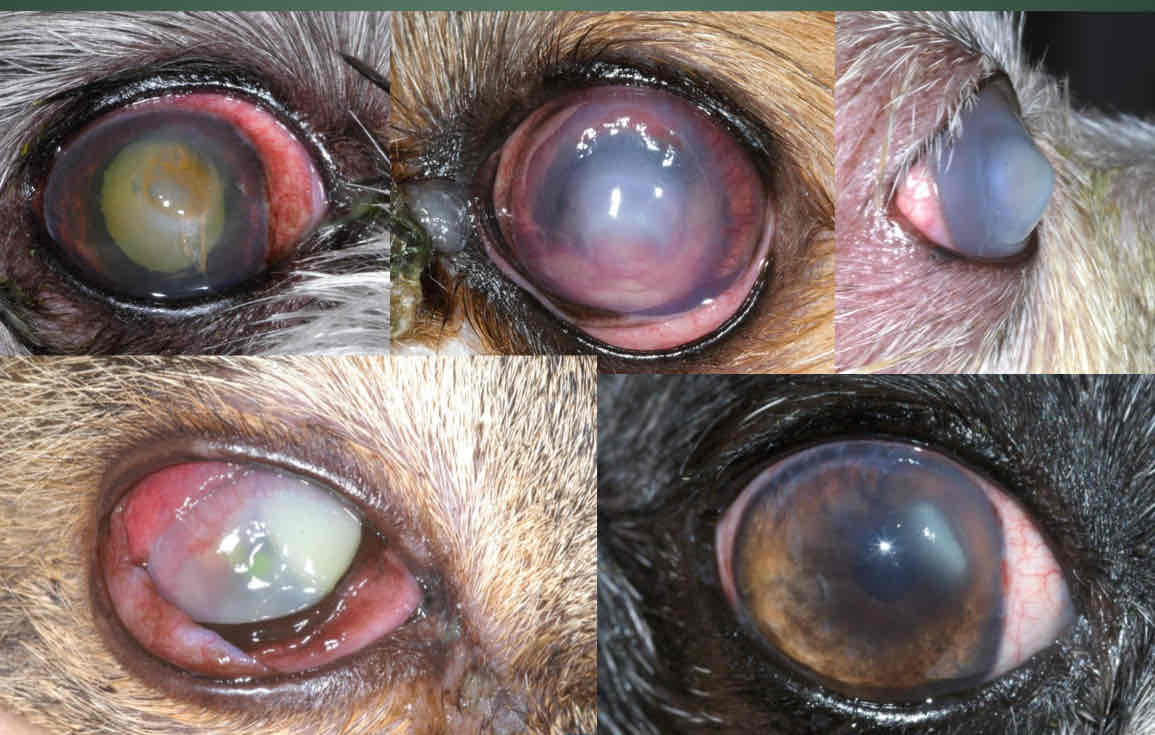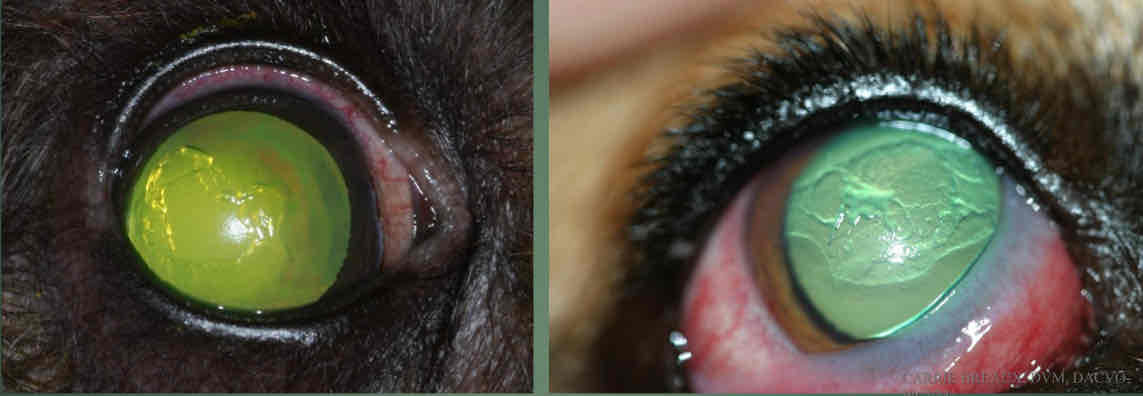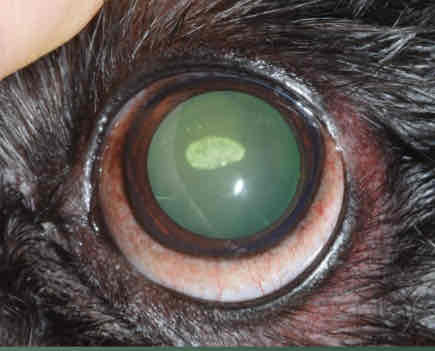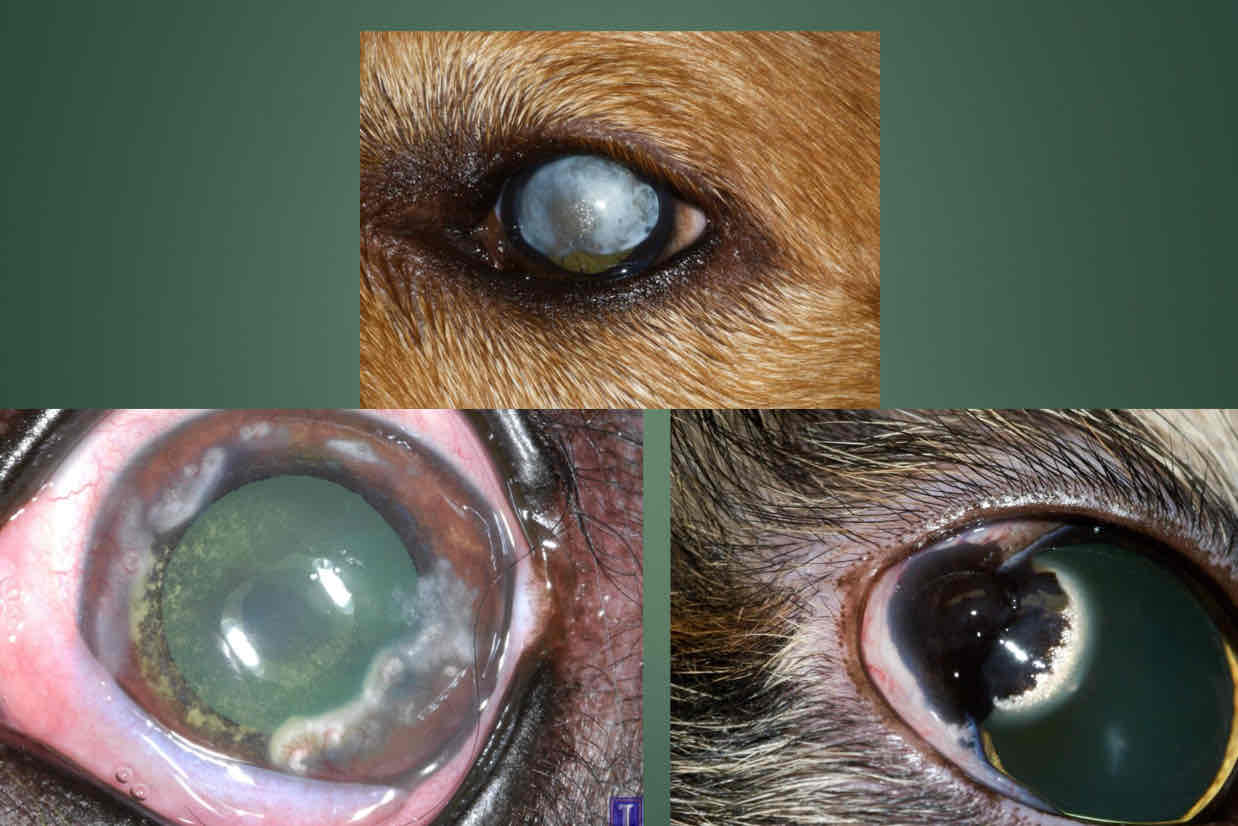Lecture 6: Cornea
1/61
There's no tags or description
Looks like no tags are added yet.
Name | Mastery | Learn | Test | Matching | Spaced |
|---|
No study sessions yet.
62 Terms
What is the most densely innervated structure?
Cornea
Where are more nerve endings found?
In epithelium/superifical cornea
What nerve innervates the cornea?
Trigeminal (CN V)
What breeds have decreased cornea innervation?
Brachycephalics
What stimulates the reflex stimulation of CN V to anterior uveal tract?
Any stimulation of the corneal nerves
What does all keratitis create?
Some degree of reflex uveitits
What causes corneal ulcers
Stimulation of CN V to→ reflex uveitis with painful ciliary body muscle spasm
How can you relieve painful ciliary body spasm?
Cycloplegic drug (atropine)
True or false, stormal and epithelial wounds heal the same
False
What are the characteristics of epithelial wound healing?
Epithelial cells lose adhesion to basement membrane
Mitosis w/increased cell numbers
Migration of cells until defect close
Re-establishment of basement membrane adhesion
Compare and contrast epithelial and stormal wound healing
Epithelial healing
Happens quickly
Minimal fibrosis hence minimal loss of transparency
No treatment currently available to speed epithelization
Stormal healing
Happens slowly
Requires activation, transformation, and migration of keratocytes into fibroblasts
May require vasculization
Fibrosis intially, followed by collagen synthesis
Epithelization proceeds resolution of stormal remodeling
What are the 2 pathologic states of corneal disease?
Loss of transparency
Loss of thickness
Match the letter with the right number
Flurescien sodium
Epithelium
Stroma
Descemet’s membrane
A. Hydrophilic
B. Hydrophobic
Hydrophilic
Hydrophobic
Hydrophilic
Hydrophobic
Characteristics of simple corneal ulcers
Superficial
Not infected
Heal in appropriate amount of time
No complicating factors
What should you look for to tell if a corneal ulcer is infected?
Cellular infiltrate in stroma and/or a melting stroma
When should normal corneal ulcers heal?
About a week
What are some common complicating factors?
Entropion
KCS (dry eye)
Eyelid tumors
Lagophthalmos
Ectopic cilia
Trigeminal neuropathy
Systemic disease (ie. Cushings, diabetes mellitus)
Distichiasis
What is the most important pinciple of superficial ulcer treatment?
You aren’t actually making the ulcer heal
What should you use to treat superifical ulcer?
Broad spectrum topical antibiotics
Analgesia (3-5 days)
E-collar to prevent self trauma
When should you recheck normal dogs with superifical ulcers?
5-7 days
When should you recheck brachycephalic dog with superifical ulcer?
2-3 days
Why do you have to recheck brachycephalic dogs sooner?
- Decreased corneal sensation
– Lagophthalmos
– Evaporative keratitis (from
not blinking)
– Increased incidence of KCS
– More likely to experience
complications in healing
What are characteristics of complicated ulcer?
Deep (loss of stroma)
Infected/melting
Complicating factors present
Slow to heal

Stormal loss

Corneal perforations with fibrin plug

Melting ulcer
How do you treat complicated ulcer with stormal loss?
Surgical grafting (Stormal loss >50% or cornea is perforated)
Rule out infection (C/S or cytology)
Control any infection (Topical antibiotics Oflaxacin, Tobramycin, Cefazolin)
Control secondary uveitis (atropine topical 1%)
Provide analgesia (Tramadol or gabapentin)
Topically anti-collagenase/protase
E-collar
Oral sedatives if necessary
Parital temporary tarsorrhaphy
How do you treat a perforated cornea?
Broad spectrum antibiotic (Clavamox)
Partial temporary tarsorrhaphy
No ointments
No topical atropine
How do evaluate a patient with a corneal peroration?
Does the eye have poetical to see
Is the perforation sealed
How do you treat an ulcer with complicating factors?
Treat the complicating factors
Treat as simple ulcer once complicating factors are resolved
When in doubt question the diagnosis not the treatment

Superifical, loose, non-adherent epithelial flaps. Usually limited vascularization.
Indolent corneal ulcers
Pathogenesis of indolent corneal ulcers
Failure of normal adhesions between epithelium and its basement membrane and underlying stroma
Treatment of indolent ulcer
Diamond burr diabridement or grid keratomy
± sedation
Topical anesthesia
Cotton tip applicators
E-collar
Atropine
Broad spectrum antibiotic (Terramycin or doxycycline)
Analgesia
What indolent ulcers should you not grid or burr?
Complicated ulcers or cats
Most common cause of corneal ulcers in cats. Remains dormant in neurons until elicited by a stressful event. Dendritic ulcers are a classic sign.
Feline herpesvirus-1
Treatment of FHV-1 ulcer
Topical Cidofiovir
Systemic anti-viral (Famciclovir)
L-lysine
Minimize stress

Bilateral, non-painful, non-progressive. Does not interfere with vision. Seen in purebreeds.
Corneal dystropy

Unilateral or bilateral, usually asymmetric. Associated with concurrent ocular surface or intraocular disease. systemic implications (hypothyroidism, hyperlipidemia). Often associated with ulceration of overlying epithelium
Corneal degeneration
How do you treat corneal degeneration?
ID any concurrent ocular or systemic disease and treat
Strongly consider referral

Disorganized collagen. Associated with previous keratitis. Maybe associated with vascularization and pigmentation. Nonpainful. Does not need treatment.
Corneal fibrosis

Can be tan, brown, or white if chronic. Clumps of inflammatory cells/protein/fibrin that adheres to endothelium. Pathognomonic for anterior uveitis. May have a lipid component
Keratin precipitates

Epthelium natural barrier to edema.
Corneal edema
Differential diagnosis for corneal edema
Ulcerative keratitis
Non-ulcerative keratitis
Keratic precipitates
Anterior lens luxation
Differential diagnosis for diffuse corneal edema
Glaucoma
Anterior uveitis
Endopthlamititis
Endothelial dystrophy
Senile endothelial degeneration
Immune mediated endotheliltis
Blue eye CAV I (very rare)
What diseases of the corneal can lead to corneal edema?
Corneal endothelial dystrophy (breed-related, middle aged dog)
Senile endothelial dystrophy
What breeds are commonly affected by corneal endothelial dystrophy?
Bostons, Dachshunds, Chihuahua, Basset hounds
How do you treat endothelial dystrophy and endothelial degenation?
Topical hyperosmotics
Keratoleptenesis
Thermokeratoplasty
What are almost all red corneal opacities?
Vascularization of the cornea
What disease is associated with corneal vascularization?
Ulcers involving stormal loss
Indolent ulvers
KCS/dry eye
Intraocular disase
Pannus
Eosinohphilic keratitis
Immune mediated corneal disase of german shepherds, mixes, and sight hounds
Pannus (aka chronic superifical keratitis)
CS of pannus
Superifical vascularization
Pigmentation
Corneal degeneration
Fibrosis
How do you treat pannus?
Topical prednisolone
Topical cyclosporine
Recheck in 2 months
Best can manage on CSA or tacrolimus alone
Liefelong treatment
May be related to FHV-1. Raised pink/white plagues extending from limbus towards the axial cornea with associated vascularization. Variable ocular pain. Usually unilateral.
Eosinophilic keratitis
How do you treat eosinophilic keratitis?
Cyclosporine or tacrolimus
Topical megaestrol acetate
Megestrol acetate
Topical steroids
L-lysine
Brown pigment is:
A. Specific
B. Non-specific
B. Non-specific
What diseases are associated with pigment?
Pigmentatary keratopathy
Adnexal neoplasia/entropion and chronic endema
A genetic disease in pugs. Goal is to prevent pigment from covering entire cornea
Pigmentatory keratopathy
Medical treatment of pigmentatory keratopathy
Treat any associated KCS
Immunodulatory meditators (Cyclosporines)
Topical steroids are dangerous
Lubricants
Treatment is lifelong
Surgical treatment of pigmentary keratopathy
Medial canthoplasty (correct entropion, decreased lagopthalmos)

3-4 years old and 7-10 years old. German shepherds, goldens, and labs. Tend to be more aggressive in younger dogs.
Limbal melanoma
What animals are predisposed to corneal feline sequestrum
Brachycephalic cats
Feline corneal sequestrum treatment
Keratectomy to remove lesions (<50%)
Grafting procedure (>50%)
Support topical antibiotic
analagesia with intermittent topical atropine